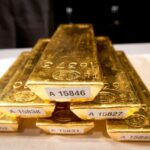By Tom Ozimek
President Donald Trump announced on Aug. 11 that gold would be exempt from tariffs, easing investor concerns over a potential sharp rise in import costs of the precious metal and sending prices lower.
“Gold will not be Tariffed!” Trump said in a social media post on Monday.
The statement followed a U.S. Customs and Border Protection (CBP) ruling that 1-kilogram and 100-ounce gold bars imported from Switzerland would be subject to a 39 percent tariff. That decision—issued July 31 but first disclosed on Aug. 7—sparked a surge in gold futures to record highs this past week, prompting the White House to say a presidential decree would be forthcoming.
“The White House intends to issue an executive order in the near future clarifying misinformation about the tariffing of gold bars and other specialty products,” a White House official told The Epoch Times. The comment came in response to questions about whether the CBP ruling applied only to specific Swiss-made gold products or more broadly to all 1-kilogram and 100-ounce bars, as Switzerland’s gold industry association contends.
The Swiss Association of Manufacturers and Traders in Precious Metals warned in an Aug. 8 statement that the CBP’s determination “may negatively impact the international flow of physical gold,” adding that it “does not apply exclusively to Switzerland but to all 1kg and 100-oz gold cast bars imported into the USA from any country.”
Under Trump’s reciprocal tariff framework, effective Aug. 7, Swiss imports face a 39 percent tariff. The Swiss gold industry has cautioned that if such a rate applies to gold bars, exports to the United States would become “economically unviable.” One-kilogram bars are the most common form traded on the Comex metals exchange.
For decades, Swiss gold bars entered the U.S. duty-free. Trump’s April 2 executive order explicitly exempted “gold, nonmonetary, bullion and dore” from reciprocal tariffs—covering goods classified under tariff code 7108.12.10, which includes investment-grade unwrought gold bars. Dore is a semi-pure alloy of gold and silver.
However, the CBP ruling classified certain 1-kilogram and 100-ounce cast bars under code 7108.13.5500—“semi-manufactured” gold—which is not covered by that exemption, leaving them potentially subject to tariffs.
The apparent change triggered panic buying on Aug. 7, with Comex gold futures briefly topping $3,510 per troy ounce before retreating to around $3,458 after the White House pledged clarification. Trump’s latest assurance sent futures down further to about $3,403. No executive order has yet been issued, and Trump’s post did not offer specifics beyond declaring that gold would not be tariffed.
The rally in gold prices also reflects broader market sentiment, with analysts pointing to sustained central bank demand, rising exchange-traded fund (ETF) holdings, and expectations of interest rate cuts as additional drivers. On Aug. 7, ING raised its gold price forecast, citing persistent geopolitical and monetary risks.
“Central banks are still buying, Trump’s trade war is still going on, geopolitical risks remain elevated, and ETF holdings continue to expand—all underpinning gold prices at the current levels,” ING Commodity Strategist Ewa Manthey wrote in a note.
ING now expects gold to average $3,400 per ounce in the third quarter and $3,450 in the fourth, raising its full-year forecast to $3,250.
Gold is already up more than 30 percent year to date, easily outpacing the S&P 500’s gain of just under 7 percent.





